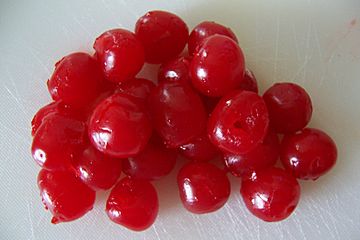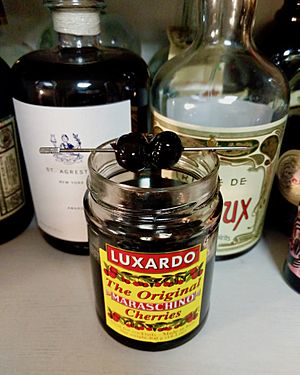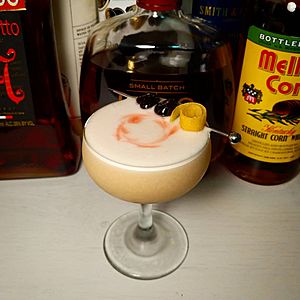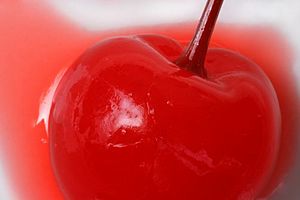Maraschino cherry facts for kids
A maraschino cherry is a special kind of preserved, sweet cherry. These cherries are usually light-colored, like the Royal Ann or Rainier varieties. To make them, the cherries are first soaked in a salty liquid. This liquid helps to make the fruit lighter in color. After that, they are soaked in a sugary syrup. This syrup also contains red food coloring, which gives them their famous bright red look.
Contents
What Are Maraschino Cherries Used For?
Maraschino cherries are used in many drinks and desserts. They are often called cocktail cherries because they are popular in drinks like the Tequila Sunrise and the Shirley Temple. Sometimes, people even add them to a glass of Coca-Cola to make a homemade "Cherry Coke".
These bright red cherries are also great for decorating food. You can find them on frozen yogurt, cakes, and milkshakes. They are a key part of an American ice cream sundae. This is why people sometimes say "cherry on top" to mean the best part of something. Maraschino cherries are also often found in canned fruit cocktail.
How Maraschino Cherries Started in Europe
The name maraschino comes from a special cherry called the marasca cherry. This cherry is originally from Croatia. It was used to make a drink called maraschino liqueur. People would crush and preserve marasca cherries in this liqueur. Whole cherries kept in this way were known as "maraschino cherries." This was a local way to preserve fruit in a place called Dalmatia.
In the 1800s, these cherries became popular across Europe. However, there were not many marasca cherries available in Dalmatia. This made them a fancy treat for kings, queens, and rich people. Because marasca cherries were rare, other types of cherries were preserved in different ways. These were also sold as "maraschino" cherries.
Maraschino Cherries in the United States
Maraschino cherries first came to the United States in the late 1800s. They were served in fancy bars and restaurants. Since they were hard to find and expensive, American producers started trying other ways to preserve cherries. They used flavors like almond extract and different types of cherries, such as Queen Anne cherries. At this time, using alcohol to preserve them became less common.
Rules for Maraschino Cherries
In 1912, the USDA made a rule about "maraschino cherries." They said that only marasca cherries preserved in maraschino liqueur could be called "maraschino cherries." Other cherries, like the artificially colored and sweetened Royal Anne variety, had to be called "Imitation Maraschino Cherries."
A New Way to Make Cherries
During a time in the U.S. called Prohibition (starting in 1920), it became illegal to make or sell alcohol. This meant the alcoholic version of maraschino cherries was also against the law.
Ernest H. Wiegand, a professor at Oregon State University, created the modern way to make maraschino cherries. He developed a method using a special salty liquid instead of alcohol. This is why most maraschino cherries today are not made with maraschino liqueur. They only have a historical connection to it.
Professor Wiegand's goal was to find a better way to preserve cherries so they would not get soft. Even before Prohibition, people were already preserving maraschino cherries without alcohol. Wiegand took these different ways of preserving cherries and turned it into a scientific process. This made it easier for everyone to make them the same way.
Changes in Coloring and Flavor
After Prohibition ended, the cherry industry wanted new rules for canned cherries. In 1940, a new rule was set. It said that "maraschino cherries" are "cherries that have been dyed red, soaked in sugar, and packed in a sugar syrup flavored with oil of bitter almonds or a similar flavor."
Over the years, some food dyes were removed from the approved list. For example, in 1960, some red and yellow dyes were no longer allowed. In 1965, a dye called Red Number 4 was allowed again for maraschino cherries. This was because the cherries were seen more as a decoration than a main food. However, in 1976, the ban on Red No. 4 was put back in place.
Today, most American maraschino cherries use a red food dye called FD&C Red 40 to get their bright color.
See also
In Spanish: Guinda al marasquino para niños






